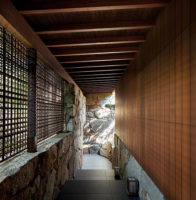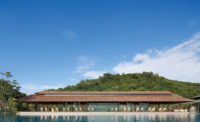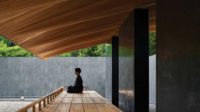Tokyo, Japan
In Japan, where few buildings are made to last, trees are mostly dispensable, and real estate remains among the world’s priciest, most architects simply nod politely to the notion of context. But the Tokyo-based designer Hiroshi Nakamura worships it. Whether they are cupping leafy boughs, jutting between tree trunks, or echoing urban eclecticism, his quirky buildings fit their sites as perfectly as toes in a tabi sock. Nakamura’s environmental awareness began during his childhood in the city of Kanazawa, where he liked to build nestlike cardboard houses. As a student at Meiji University, he caught the attention of Kengo Kuma, who was serving as a competition juror and offered him a job in 1999.
In his three years at Kuma’s office, Nakamura ran several small projects through to completion and learned from the skilled craftsmen and carpenters who often collaborate with the firm. As project architect for Plastic House in Tokyo, he saw how Kuma used contemporary materials, a skill he would need on the commission that launched his solo career — a high-profile boutique in the heart of Ginza for the French fashion house Lanvin. The client for this project, who had wanted a young architect from the start, hired Nakamura after visiting Plastic House. At Plastic House, a translucent plastic skin admits daylight inside; but at Lanvin, Nakamura punctured the facade with clear acrylic cylinders to dot the shop interior with daylight. Following his mentor’s model, he worked closely with fabricators, in this case shipbuilders, to create the boutique’s unique facade. It consists of two layers of steel plate punctured with 3,000 portholelike openings and pinned together by the acrylic pegs.
Nakamura continued to craft his architecture with House C, a weekend retreat for a young family near the Chiba Prefecture coast. A large, one-room dwelling looking out to sea, the building takes a literal approach to fitting into its setting. Using trowels and shovels, family members teamed up with Nakamura’s staff to slather the entire exterior with ocher-colored soil from the site and plant native grasses on the roof. But Nakamura’s reverence for nature isn’t limited to the countryside. His project Dancing Trees, Singing Birds — a six-unit housing complex in central Tokyo, nestles within an existing grove of trees, with each apartment crafted to fit between the trunks and branches. In a similar vein, the recently completed Roku Museum dips and swoops to mold itself around the site’s newly planted trees.
Right now, Nakamura is working on Upper Forest, a large commercial complex that will actually add trees to the city. Won in an international competition, the project stands at the key intersection of Meiji Street and Omotesando, Tokyo’s elegant boulevard lined with designer boutiques and rows of leafy zelkovas. Nakamura’s design calls for a collage of small volumes that will hold tenant spaces and respond to the neighborhood’s chaotic built environment; a rooftop garden will echo the greenery at grade.
Nakamura’s ecological stance breaks with convention in Tokyo, where organic growth usually means the steady cycle of demolition and construction. His care and respect for landscape seems rooted in the past but also bodes well for the city’s future, establishing an important precedent for the next crop of designers.
Hiroshi Nakamura & NAP Architects
LOCATION: Tokyo, Japan
FOUNDED: 2002
DESIGN STAFF: 12
PRINCIPAL: Hiroshi Nakamura
EDUCATION: Meiji University, M.Arch., 1999; Meiji University, B.Arch., 1997
WORK HISTORY: Kengo Kuma & Associates, 1999—2002
KEY COMPLETED PROJECTS: Roku Museum, Tochigi, 2010; House C, Chiba, 2008; Dancing Trees, Singing Birds, Tokyo, 2007; Lotus Beauty Salon, Mie, 2006; House SH, Tokyo, 2005; Lanvin Boutique Ginza, Tokyo, 2004
KEY CURRENT PROJECT: Jingumae Forest Building, Tokyo, 2012
WEB SITE: www.nakam.info














Post a comment to this article
Report Abusive Comment